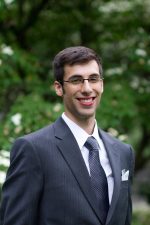For his work on the Mu2e experiment at the U.S. Department of Energy’s Fermi National Accelerator Laboratory, physicist Richard Bonventre of the U.S. DOE’s Lawrence Berkeley National Laboratory has earned the 2018 Universities Research Association Tollestrup Award, which recognizes outstanding postdoctoral research at Fermilab or in collaboration with Fermilab scientists.
URA and Fermilab scientist Alvin Tollestrup, for whom the award is named, will recognize Bonventre at the Fermilab Users Meeting on June 20.
“His work has consistently pushed the envelope of what can reasonably be expected of prototype detectors,” according to a statement from the award committee.
“I think that Richard is precisely the sort of physicist that Alvin Tollestrup had in mind when he created this award,” said Tollestrup Award Committee Chair Michael J. Mulhearn of the University of California, Davis. “He is someone that intuitively knows what is needed to make an experiment work, and he keeps at it until he has the best result possible.”
Researchers on the Mu2e experiment look for evidence that muons can change directly into electrons. The telltale signature of this decay is an electron with an energy of 105 million electronvolts (MeV). The rate of this conversion is so rare that in order to catch just one instance of this phenomenon, the detector must track decay products from 1 billion billion muons, which are as many muons as there are grains of sand on Earth’s beaches.
Bonventre helped develop the electronics for the prototype Mu2e detector as well as the prototype itself. The electronics take measurements of the muon conversion via a part of the detector called the straw tracker. The electrons produced from the muon decay will zip down the approximately 20,000 straws, which have sense wires running through the middle that are a quarter the width of a human hair. He programmed computer chips to record the arrival time and position of the particles passing through the straws. The timing and position information are later used to precisely determine the momentum of the passing particle, which can vary between the momentum of a normal electron and neutrinos that appear from standard muon decay and that of the special 105-MeV electron.
“A lot of my work was finding arbitrary parts around Berkeley Lab and putting all the pieces together to get the result of the prototype detector,” Bonventre said.
He also took spare pixel detectors from the ATLAS experiment at the Large Hadron Collider at CERN and used them to track the particles. The pixels in these detectors are small enough to precisely measure where the particles passed through the straw.
Following Bonventre’s work on the straw detector electronics, the prototype detector achieved the sensitivity levels needed for this experiment. The Mu2e experiment will be 10,000 times more sensitive than previous experiments that searched for the elusive 105-MeV electron.
“The work I have done with hardware and firmware isn’t easy to present, so I am really happy that is has been recognized,” Bonventre said.
His Berkeley Lab supervisor, senior scientist David Brown, said he was gratified by Fermilab’s recognition of Bontventre’s efforts.
“This award credits Richard’s resourcefulness and technical expertise in constructing and testing a prototype of the Mu2e tracker, the most sensitive detector in the experiment. Richard’s prototype work and corresponding simulations demonstrate that the detector and electronics design meet the exacting requirements for Mu2e to meet its scientific goals,” Brown said.
“We congratulate Richard Bonventre for so ably fulfilling the expectations that a Tollestrup awardee pushes the boundaries of the field,” said URA Executive Director Marta Cehelsky.
Bonventre said he was thankful for the honor.
“I am very humbled to win this award and want to thank my colleagues on Mu2e for all of their help,” Bonventre said. “I’m looking forward to applying what we have learned to our full-scale system and making world-class measurements.”




